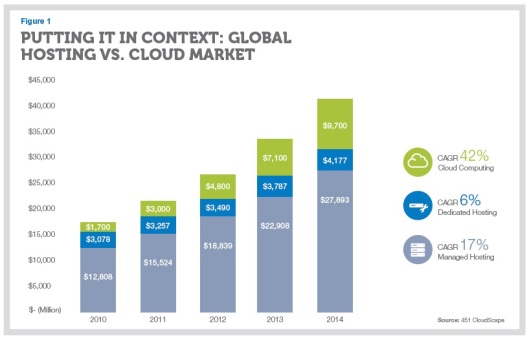A 451 Research study reports that market for cloud services is growing rapidly (as showed in an Interxion study), predicting a CAGR (Compound Annual Growth Rate) of 24% from 2011 to 2015. Besides, that report compares the cloud market with the traditional hosting market. (Note: The hosting market consists of dedicated hosting and managed hosting; and to be able to make a comparison between cloud and the hosting market the study have chosen to leave out SaaS from Cloud market and reduce cloud computing to IaaS and PaaS). When comparing the cloud computing to the traditional hosting market, as showed in the next figure, we see that although cloud computing share is growing rapidly (CAGR of 42%), with a total value of $4.8bn in 2012, it is still a relatively small share (18%) compared to the hosting market:
The above table shows how the provision of infrastructure services is still dominated by hosting providers offering traditional hosting services, but cloud growing figures let foresee that cloud-based technologies will start to overtake the traditional market.
Besides, IT spends are shifting from traditional IT services from Cloud Services:
Besides, according to a study developed by PC-Connections, 69% of organizations are considering implementing Cloud or already have some application in the cloud:
And 50% of organizations have assessed its environments to determine if they are suitable for Cloud:
Therefore, let’s go deep in the Cloud Market, and we’ll review its current drivers and barriers; given that in the last year I‘ve treating direct or indirectly different sorts of Cloud barrier in several posts (“Cloud Computing Countries Ranking, or the Cloud Confusion even among market analyses: BSA vs Gartner vs IDC”, “Interoperability: a key feature to ask your Cloud Service Provider for”, “An infographic about Security and other Cloud Barriers”, “Cloud Computing and the EU Digital Agenda: A step in the right way, but too short” and so forth) let me focus in the drivers, and we’ll do it extracting data (as done in the prologue of this post) of several cloud market reports, that in some cases show different numeric results, even contradictory, but that they agree in the main: the relationship and importance of the main drivers.
According to the third annual “Data Center Industry Survey” (2013) of The Uptime Institute, there are a lot of factors driving public cloud adoption, from speed of deployment, scalability and potential cost savings. But the breakout driver for cloud computing adoption in 2013 is end-user or customer demand. In 2012, only 13% of respondents listed customer demand as a top driver, versus 43% in 2013, making it the leading driver over all other factors driving public cloud deployments:
Similar results are obtained by the study conducted by Orange, although the figures (and consequently the ranking) are different:
Referring to this subject, a study conducted by Forrester Research (in behalf of IBM) shows that the 2 top applications that companies are interested in moving to the Cloud are clearly driven by the user: both the external customer and the internal employees:
In consequence all of them agree on:
the importance of cost reduction as well as the growing importance of focusing in the customer demands as key drivers.
Besides, curiously, there are gradual changes in the way enterprises procure technology. With or without the blessing of IT, departmental and line-of-business managers are increasingly going direct to providers for SaaS apps or IaaS offerings. In fact, Gartner forecasts that the CFO (Chief Financial Officer) will spend as much on technology as the CIO (Chief Information Officer) by 2017. A lot of that investment will go to customer-facing “systems of engagement”, mainly relating to e-commerce, which needs cloud infrastructure to scale properly and meet the highly variable demands of public Web and mobile apps.
Finally, directly in relation with the last sentence, according to an Aerohive Networks infographic the 3 main advantages of using Cloud Services are:
- Instant Scalability
- Fast Deployment
- Automated backup & updates
And clearly the first two of them are aligned (and the third too) with the increasing user demand which forecast is based on, at least, the next points:
- 90% of organizations will support corporate applications on personal devices by the end of 2014 (Gartner, “Plan Now for the Hyperconverged Enterprise Network”, May 2012) ,
- 1,04 billions of smartphones and tablets will be shipped in 2014 overcoming for first time the number of normal mobiles (IDC, Worldwide Quarterly Mobile Phone Tracker,)
- and Morgan & Stanley estimates that the mobile web will be bigger that desktop internet by the end of 2015.









No hay comentarios:
Publicar un comentario